A Primer on Warships
The century after World War I has witnessed an unprecedented evolution of naval warfare and engineering. Compared with the battle fleets that mobilized in 1914, today's navies are practically unrecognizable thanks to the development of aircraft carriers, specialized amphibious fleets, and the increasing sophistication of submarines, which have become capital ships in their own right. The following is a list of all ship types that are covered in this site, and a few that aren't. Aside from a few exceptions explained below, ships of under 1,000 tons (some margin allowed) are not included in the database or on Navbase.
By and large, US/NATO hull classification symbols are used to abbreviate ship types on this site although there are some exceptions.
Aircraft Carriers
Fleet Carrier (CV): These are the standard large aircraft carrying ships that were first built during the inter-war period. They typically displace more than 20,000 tons and can carry between 30-100 single-engine piston aircraft. Early fleet carriers were often built as conversions from incomplete capital ships that were laid down during or shortly after World War I but could not be completed due to the Washington Naval Treaty.
Attack Carrier (CVA): There is no formal distinction between a CV and a CVA; in fact, the US Navy discarded the CVA designation in 1975. However, for purposes of this site, the difference between a CV and a CVA is that the latter is specifically designed to operate jet aircraft. As such, a CVA will feature an angled flight-deck, steam catapults, and a mirror landing system, the three main post-war innovations for operating jet aircraft at sea. Likewise, the number of aircraft carried represents how many of the larger jets such a ship can carry, rather than piston-engined aircraft (this explains why CVA conversions of former CVs like the Essex- and Midway-class will show lower aircraft). A typical CVA displaces at least 40,000 tons and can carry over 40 jet aircraft as well as helicopters. The invention of the ski jump has also resulted in some CVAs lacking steam catapults as is the case of the Russian Kuznetzov-class ships.
Nuclear Aircraft carrier (CVN): A nuclear-powered CVA. Only two countries, the US and France, have built such ships. The largest warships in the world are currently the US Navy's fleet of ten Nimitz-class CVNs, each of which displaces around 100,000 tons and can carry over 80 aircraft and helicopters. This essentially gives a single Nimitz-class ship more firepower than most country's entire air forces. The sole French CVN is the Charles de Gaulle, considerably smaller at 40,000 tons but features much of the same capability as its US counterparts albeit with a reduced number of aircraft (around 40).
Light Carrier (CVL): Light carriers were originally designed as smaller versions of the fleet carriers, that could be built quicker. They typically displaced less than 20,000 tons and could carry no more than 30-40 aircraft. Most of the initial attempts at creating aircraft carriers such as the Royal Navy's HMS Argus, the US Navy's USS Langley and the Japanese Navy's Hosho were light carriers. Although many WW2 light carriers soldiered on in the post-war era, the concept of the light carrier was given a new lease of life late in the Cold War thanks to the Royal Navy's Illustrious-class CVLs, designed to carry vertical/short-take off (V/STOL) aircraft like the Harrier and equipped with a ski ramp for takeoffs with heavier payloads, an innovation that has since been incorporated even into larger carriers. The Illustrious-class has since been widely copied by medium-sized navies which could otherwise not afford the larger CVAs or CVNs. Most can carry up to 20 Harriers or helicopters (usually a mix).
Helicopter Carrier (CVH): This is another vague and overlapping designation that can refer to ships of varying size and role. Furthermore, the theoretical ability of most modern CVHs to operate V/STOL aircraft means that the distinction with a CVL is often a matter of politics. For example, the Japanese Hyuga- and Izumo-class are designed as CVHs because its constitution does not allow aircraft carriers; however, it would not be particularly difficult to fit them out to operate F-35s if needed in the future. Although the average CVH displaces around 20,000 tons, the Soviet Kiev-class CVHs were huge ships of nearly 50,000 tons displacement and could operate Yak-38 V/STOL aircraft too. One such ship sold to India had much of its deck cleared of weapons and is now essentially a CVA. Most CVHs, however, share one thing in common: a primary role of anti-submarine warfare which sets it apart from another very similar-looking ship, the Landing Platform Helicopter (LPH) as well as other amphibious assault ships with helicopter decks.
Escort Carrier (CVE): Known colloquially as "jeep carriers", these ships were the result of a frantic effort by the Allies to build as many aircraft-carrying ships as possible. As such, they were mostly built on commercial hulls, had no protection, and were much slower than other carriers. As convoy escorts, however, they were superb and helped plug the gaps in air cover in the Atlantic. From 1943 onward, they would also be paired up with frigates and destroyer escorts into anti-submarine hunter-killer groups, effectively putting the U-boats on the defensive. Around four-fifths of all carriers built in World War II were escort carriers, most built by the US but a few others by Britain (which also received a large number from the US via Lend-Lease) and Japan. None have been built since World War II.
Seaplane Tender (AV): Seaplane tenders were floating bases for seaplanes which lacked a proper hangar but had facilities for operating and repairing seaplanes while at sea. Most were converted from merchant vessels. For purposes of this site, seaplane tenders are considered auxiliary ships but some were converted into aircraft carriers while others were converted from combat types such as US Navy destroyers during World War II (where they received the AVD hull classification).
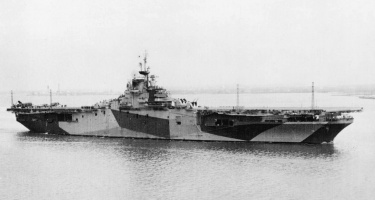 |
The Essex-class was the pinnacle of World War II carrier design, able to carry around 100 aircraft. No less than 14 of these ships served during the war (out of 24 ultimately completed) and, despite their weaker protection compared to comparable British carriers, none were sunk during combat. |
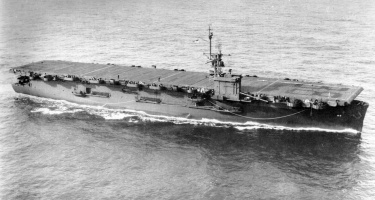 |
Escort carriers like the Casablanca-class were some of the unsung heroes of World War II, making it possible to provide air coverage to convoys and basically showing that aircraft carriers could also be extremely useful in the anti-submarine role. |
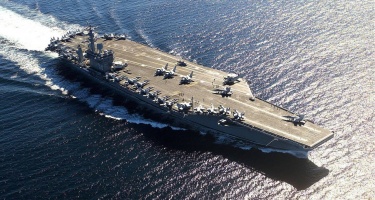 |
The Nimitz-class (and its successor, the Ford-class) is currently the symbol of the US Navy's global power projection, and are unmatched in size and sophistication. Aside from the US and France, no other nation has yet to build a nuclear-powered aircraft carrier. |
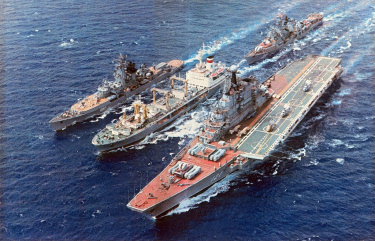 |
The Soviets came late to carrier development, but the Kiev-class helicopter carriers were nevertheless impressive, featuring a formidable array of armament (which carriers usually lacked) and the ability to carry V/STOL aircraft like the Yak-38 as well. |
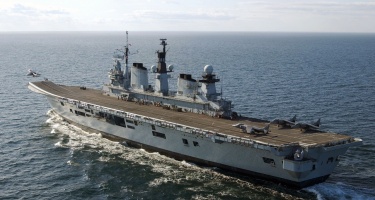 |
The introduction of V/STOL aircraft like the Harrier brought naval air power to navies that otherwise would not be able to afford larger conventional carriers (to say nothing of nuclear ones). Thanks to this, more navies have carriers like this Invincible-class today than ever before. |
Capital Ships
Battleship (BB): Battleships were the queens of the sea from the late 19th century up until World War II. Modern battleships followed the basic design of the revolutionary HMS Dreadnought of 1905 which pioneered the use of an "all-big-gun" battery of the largest possible caliber. Battleships gradually increased in size, first with the World War I-era "Super Dreadnoughts" of the Royal Navy's 30,000t Queen Elizabeth-class with 15-in guns, and later even larger 40-50,000t ships of 16-in caliber in the US and Japanese navies during World War II; the 70,000t Japanese Yamato-class went even further with 18-in guns, the largest ever fitted on a surface ship. Although battleships distinguished themselves well in the war, the advent of aircraft carriers made them obsolete by war's end and aside from the HMS Vanguard (1946), no new battleships have been built since. Nevertheless, their value as shore bombardment platforms meant that the US recurrently recommissioned its four Iowa-class ships throughout the Cold War. These were extensively modernized into Tomahawk missile platforms during the 1980s where they served as flagships of battlegroups as a counter to the Soviet Kirov-class battlecruisers. All were retired after the Cold War.
Battlecruiser (BC): Battlecruisers were developed in the early 20th century as ships that were faster but equally powerful as battleships, the trade-off being weaker armor protection. It was believed that these ships could either sink or outrun any other ship they encountered. In practice, however, their weaker armor proved to be a liability as evidenced by the infamous sinking of three Royal Navy battlecruisers during the Battle of Jutland in World War I, and later, the defeat of the HMS Hood in its battle against the Bismark in World War II. The Royal Navy was the only user of battlecruisers during World War II, the sole survivor (HMS Renown) being scrapped shortly after war's end.
Guided Missile Battlecruisers (BCGN): The only capital ships built during the Cold War were the Soviet Kirov-class battlecruisers, which have no equivalent in any other navy in the world. Essentially an over-sized guided missile cruiser approximating the size of a World War II battleship, they were designed as flagships for anti-surface battlegroups during the 1980s and carried a formidable array of anti-ship and anti-aircraft missile armament. Given their size and expense it is unlikely that similar ships will be built in the near future although Russia is likely to keep its three surviving ships in active service for the foreseeable future.
Battleship-Carrier (BBV): Also known as 'hybrid carriers', these were Japan's two Ise-class battleships modified with a flight deck, prompted by the need to put as many carriers as possible into service late in the war. Suffice to say this experiment was never replicated elsewhere.
Pre-Dreadnought (OBB): Battleships built before 1905 were later referred to as Pre-Dreadnoughts. These were known for having armament of different calibers and with many guns being fitted in barbettes rather than turrets. Although obsolete by World War I, most navies retained large numbers of pre-dreadnought battleships which complemented their battlefleets and were also useful for shore bombardment. Most were scrapped as a result of the 1922 Washington Naval Treaty.
Monitors (BM): Not quite capital ships per se, monitors were smaller, coastal ships that were designed for shore bombardment. They were armed with guns equally as powerful as those of battleships, though in much fewer numbers (usually in a single forward turret). Monitors were mostly used by the Royal Navy in World War I though a pair of survivors of the Erebus-class saw extensive World War II service, notably on D-Day.
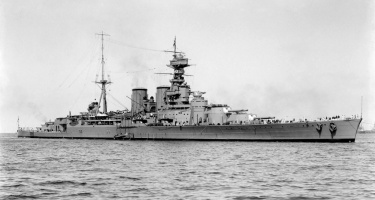 |
The mighty HMS Hood battlecruiser was the Royal Navy's largest capital ship at the start of World War II, but its weaker armor compared to a battleship led to its demise at the hands of the German Bismark in the fateful Battle of the Denmark Strait. |
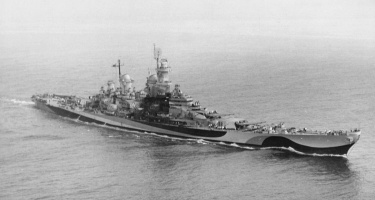 |
The Iowa-class was the final and finest US battleship class of World War II, though by this time the age of the battleship was over and they did not fire their guns in anger against another one of their kind. But they returned to duty in the 1980s armed with Tomahawk missiles. |
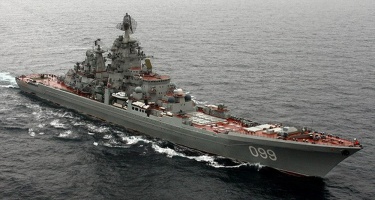 |
The Soviet Kirov-class has been the only attempt to create a modern, guided-missile-based capital ship. Despite being the most powerfully-armed surface warship ever built, many smaller ships can now carry a similar array of anti-aircraft and land-attack weaponry. |
Cruisers
Heavy Cruiser (CA): Heavy cruisers were the most powerful non-capital ships afloat up until the early Cold War period. They are the direct descendants of Armored Cruisers (OCA) and are differentiated from Light Cruisers by having main armament of over 6-in caliber as defined by the 1922 Washington Naval Treaty; in most cases they also had stronger armor but were slightly slower. The US and Japanese navies were the main users of Heavy Cruisers up to and during World War II and both sides built incredibly powerful ships of this type such as their respective Baltimore- and Takao-class ships, which exceeded 15,000t displacement and had between 9-10 8-in guns (Japanese ships were also torpedo-armed). The Royal Navy was also a major user of heavy cruisers (namely the superb County-class) though they prioritized range and seaworthiness over firepower and protection. Heavy cruisers became rapidly obsolete in the missile age, though some of the Baltimore-class ships were converted to become the first Guided Missile Cruisers.
Light Cruiser (CL): Light cruisers were defined by the 1922 Washington Treat as any cruiser with 6-in caliber guns or less, and are the descendants of the Protected Cruisers (CP) of the late 19th and early 20th centuries. The Royal Navy was the main user of light cruisers up to World War II given the need to protect the sea lanes that connected the British Empire, a role which they were particularly well suited for given their balance of speed, firepower, and lower cost. A few nations resumed construction of Light Cruisers early in the Cold War period, notably the Soviet Union with their Sverdlov-class in the 1950s, but these too were gradually phased out in favor of missile-armed ships.
Anti-Aircraft Cruiser (CLAA): The increasing threat of aircraft in World War II necessitated the development of cruisers armed with dual-purpose armament that could serve as both anti-aircraft and gun platforms. These included the Royal Navy's Dido/Bellona classes armed with 5.25-in and the US Navy's Atlanta/Oakland classes with 5-in guns. Not all sources make a distinction between anti-aircraft cruisers and standard light cruisers as separate ship types.
Cruiser-Minelayer (CM): Large mine-laying ships were referred to as cruiser-minelayers, notably the Royal Navy's Abdiel-class. Armament and size, however, were less than even light cruisers and were closer to large destroyers.
Large Cruiser/Pocket Battleship (CB): The Large Cruiser was a concept developed in the German Deutschland-class pre-war ships. These were designed as fast and powerful merchant raiders that could conceivably defeat any cruiser that they encountered. They were popularly referred to as "pocket battleships" even though with their 11-in guns were not capital ships. Later, the much larger US Alaska-class (with 12-in guns) was designed in response, and also as heavy cruiser-killers in the Pacific. These ships (also erroneously described as battlecruisers) proved somewhat superfluous in practice an were retired shortly after the war, with no other large cruisers designed since.
Guided Missile Cruiser (CG): The era of the gun cruiser came to an end with the advent of missiles. Given their size, cruisers became the ideal ship types for carrying missiles with many former heavy and light cruisers eventually converting to missile cruisers; these were followed by the first purpose-built designs in the 1950s. Guided Missile Cruisers generally come with a combination of anti-ship and anti-aircraft missiles and many of them have considerable ASW and land-attack capabilities as well. In recent decades, missile launchers have been increasingly replaced by VLS (vertical launch systems) which allows more missiles to be carried in smaller spaces; this plus the use of unarmored aluminum hulls means that modern missile cruisers are actually smaller and lighter than their WW2 counterparts, averaging around 10,000t. The last and most modern US cruisers, the Ticonderoga-class, also pioneered the concept of the air defense ship with their AEGIS radar system, now extensively used by other allied navies. The US and Soviet navies were the sole users of missile cruisers given their expense, but now that modern destroyers (and even frigates) can pack a similar punch, no new cruiser classes have been planned since the 1980s.
Nuclear Guided Missile Cruiser (CGN): The US began building cruisers with nuclear engines in the 1960s in order to make them capable of keeping up with the nuclear carriers that were entering service that decade. However, the advantages of nuclear-powered cruisers over conventional designs was less apparent than with carriers or submarines and as a result, the Ticonderoga-class reverted to conventional powerplants in the 1980s and all existing nuclear cruisers were phased out after the Cold War.
Helicopter Cruiser (CH): Cruisers became ideal vessels in the post-war years for operating helicopters, and some were designed with large decks and hangar spaces to accommodate four or more helicopters of any size. Only a few classes were built (and a few conversions) as preference was given to purposely designed helicopter carriers or helicopter-capable amphibious ships. Those with guided missile armament are designated CGH.
Armored Cruiser (OCA): Developed in the late 19th century as ships that were capable of defeating any ship it couldn't outrun (a design philosophy later carried over to battlecruisers), Armored Cruisers were distinguished by having armored decks and sides, but this came at a cost of slow speed and poor range which made them less effective than intended in the cruiser role though they were still powerful gun platforms. They became obsolete after World War I.
Protected Cruiser (CP): A contemporary of Armored Cruisers, these ships retained an armored deck protecting vital machinery but had unarmored upper decks and sides. Despite this, they were far more useful in the cruiser role as they were not limited by speed and range. As turbine technology improved in the early 20th century, the trade-off between protection and speed became less pronounced and these ships became gradually replaced by Heavy and Light Cruisers.
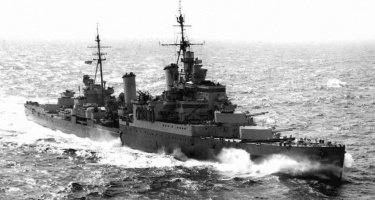 |
Light cruisers like the Town-class were the Royal Navy's primary means for securing the sea lanes of its empire and consequently built more of them than any other navy. They saw considerable action in the Mediterranean but suffered heavy losses from air and torpedo attacks. |
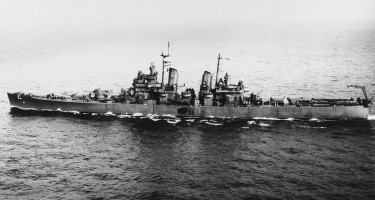 |
Heavy cruisers like the US Baltimore-class were in constant action in the Pacific serving as powerful escorts, anti-aircraft screens, and platforms for shore bombardment. Battles like Tassafaronga were almost entirely cruiser versus cruiser affairs and the Japanese often prevailed. |
| The Ticonderoga-class cruisers introduced the AEGIS air defense system and are also formidable land-attack platforms thanks to their Tomahawk missiles. But they are being phased out since smaller destroyers like the Arleigh Burke-class can do nearly the same at reduced cost. |
Destroyers
Destroyers (DD): Originally known as "torpedo boat destroyers", these ships were initially designed to screen the battlefleet against small torpedo-carrying boats around the turn of the century. They eventually evolved into multi-purpose ships that could act as surface combatants, fleet escorts, and anti-submarine ships when needed. Destroyers are, by design, the fastest ships in the fleet but can operate independently or as part of destroyer flotillas where they are often led by a destroyer leader (see below). Armament typically consists of numerous small guns (usually no larger than 5-in), torpedoes, and anti-aircraft armament. Anti-submarine weaponry such as depth charges, mortars, and rockets are also carried. Most destroyers weighed less than 1,000t before World War I but by World War II the largest classes could reach up to 3,500t when fully loaded. However, size varies: during the inter-war years a few nations (notably France and Italy) produced particularly large destroyers, whereas Britain's wartime destroyer production consisted of smaller "utility destroyers" from the War Emergency classes.
Guided Missile Destroyer (DDG): This is a destroyer equipped with either anti-aircraft or anti-ship missile armament (or both). The development of missiles in the post-war era gave destroyers significantly improved capability to the point that by the end of the Cold War, they had made cruisers all but obsolete. This was complemented by area-defense radars such as the US AEGIS or the European SMART systems. The US Navy's Arleigh Burke-class destroyers are the quintessential surface combatants of the 21st century, capable of protecting carrier battle groups against air attack, carrying dozens of cruise missiles to use against land targets, and having anti-submarine capability as well. In terms of capability, they are even on par with the Ticonderoga-class cruisers that preceded them. With guided missile frigates (FFGs) now also having similar capabilities to DDGs, the distinction between the two ship classes today is mostly based on weight (DDGs are heaver than FFGs, usually at 7,000 tons or more) or their national designations except in the cases where a country does not use the term (France, for example, refers to destroyers as frégates even though they carry the NATO D pennant).
Helicopter Destroyer (DDH): This was initially a designation used to refer to destroyers that carried an anti-submarine helicopter, used primarily by Japan and Canada. However, most destroyers now carry one which make its somewhat superfluous. There have been a few designs with extended hangar capacity and a larger deck to carry more than one and in this case, the designation is maintained insofar as the ship's anti-submarine capability is centered on its helicopters. Note that the the Japanese Hyuga and Izumo classes of CVHs are officially designated DDHs to avoid even the remote suspicion that they are offensive weapons. This fools nobody.
Escort Destroyer (DDE): Escort destroyers were destroyers designed during World War II with reduced speed to make them more efficient as convoy escorts (slower speed typically allows greater range and an ideal convoy escort should be able to cross the Atlantic without refueling). The first such type designed from scratch was the British Hunt-class of 1940, but World War I-vintage fleet destroyers (like the US "flush-deckers" and the UK V- and W-classes) were also re-designated as escort destroyers since they were no longer as fast or as powerful as the most modern destroyer types then in service. The only other nation to field such designs was Japan, which is also the only one to do so in the post-war period. Note that escort destroyers should not be confused with destroyer escorts (see below), which is the original US name for a frigate. If anything, the DDE is an intermediate ship between a true fleet destroyer (DD) and a DE.
Destroyer Leader (DL): Destroyer leaders were originally designed as flotilla leaders and were generally larger than ordinary destroyers (over 1,500t) with additional space for command and communications staff. By World War II, most destroyers were large enough to not require extra space for flotilla leader roles and so, purpose-built DLs were no longer built. The idea was revived after the war by the US Navy which assigned the role to ships that were essentially oversized frigates. Eventually with the 1975 ship reclassification, the DL designation was discarded and all ships designed became destroyers or cruisers. This site does not make any distinction between standard destroyers and leaders, and post-war US DLs are referred to by their post-1975 designations.
Radar Picket Destroyer (DDR): Late in World War II, the US pioneered the use of specially converted destroyers into the radar picket role, intended to screen the fleet for kamikaze attacks. Given the threat of Soviet air attacks, the role persisted into the early Cold War period, with the Royal Navy also converting some of its destroyers into radar pickets. The increasing sophistication of radars, plus the advent of surface-to-air missiles, later rendered the concept obsolete.
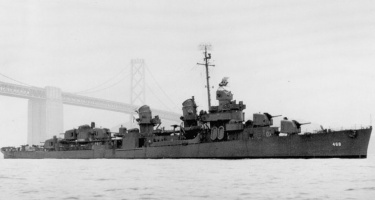 |
The US and British navies built massive destroyer fleets in World War II like those of this Fletcher-class, mainly for escort and anti-submarine duties. However, they were frequently employed in surface combat as well where their speed and combination of guns and torpedoes came in handy. |
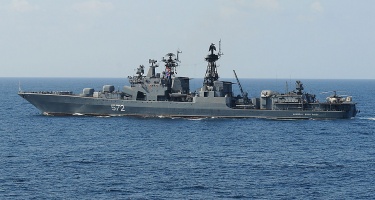 |
Destroyers remained the quintessential all-purpose ships during the Cold War although many specialized in anti-aircraft or anti-submarine roles, in the latter case like the Soviet Udaloy-class. Destroyers were usually the largest class of ships that even small navies could afford. |
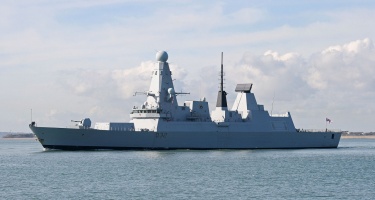 |
Destroyers can now do almost everything that cruisers can do in a slightly smaller (and cheaper) package. The Royal Navy's Type 45 destroyers, for example, are dedicated air defense platforms and others can carry land-attack weapons like Tomahawk missiles as well. |
Frigates
Frigate (FF): In the age of sail, a frigate referred to a fast ship of the line that had only one row of guns. The Royal Navy re-introduced the term in World War II to refer to a new class of ships that were of intermediate size (1,500-2,500t) and performance between a destroyer and smaller anti-submarine escorts like corvettes and sloops, and that could be built under mercantile standards in commercial shipyards. Frigates had weaker armament compared to destroyers but compensated by having all major anti-submarine sensors and weapons, including depth charges as well as Hedgehog and Squid mortars. Compared to destroyers, frigates were slightly smaller and had a slower top speed of around 20 knots which was enough to escort convoys and to out-run submarines. Their slower speed gave them greater endurance than fleet destroyers (allowing them to cross the Atlantic without refueling) and was not a liability in hunting submarines since sonar was unusable at speeds beyond its top speed. Their WW2 equivalents in the US Navy were known as patrol frigates (PF) although only one such class (Tacoma-class) existed; they are referred as frigates on this site. Destroyer escorts (DE) are also US equivalents to frigates but are taken as a separate ship type (see below).
Destroyer Escort (DE): The US Navy's equivalent to the Royal Navy's frigates during WW2, with the only significant difference being that they were built in military shipyards under military standards; a distinction that became moot in the post-war period once British frigates began being built in military shipyards as well. Like frigates, they were primarily used as anti-submarine ships in both the Atlantic and the Pacific where they frequently operated in hunter-killer groups with escort carriers. Lend-Lease supplied destroyer escorts to the Royal Navy were known as frigates during WW2 and eventually in 1975 the US Navy discarded the destroyer escort definition altogether and redesignated those ships as frigates. Aside from the US, Japan and Australia were the only other major navies that used the DE designation. This site separates destroyer escorts and frigates based purely on national designation as both ship types are considered to be identical in terms of size, performance, and function.
Guided Missile Frigate (FFG): Frigates remained the world's main anti-submarine ships throughout the Cold War and when armed with anti-air or anti-ship missiles are designated as FFG. Today they are true multi-role ships, the most modern of which can carry area-defense AA systems such as the US AEGIS or European SMART radars. They are also considerably heavier than their WW2 counterparts, weighing in at over 5,000t in many cases. The most modern designs like the Franco-Italian FREMM frigates blur the lines with destroyers in terms of capability and size. In the Soviet/Russian Navy, frigates are known as Guard Ships and are typically smaller than their Western counterparts although very heavily armed. Modern frigates that are focused on patrol or anti-submarine duties and lack major missile armament still retain their FF designation.
Multi-Mission Frigate (FFM): A relatively new designation for various frigate designs that have additional capabilities not typically found in frigates, such as the ability to undertake (limited) amphibious operations, or extended off-shore patrols and maritime security duties. The move towards modular designs will make these types of frigates increasingly popular especially among smaller navies which can get some extra bang for the buck with a single ship.
Helicopter Frigate (FFH): Frigates specifically based around ASW helicopters are designated as FFH although most modern frigates carry at least one.
Light Frigate (FFL): Another intermediary ship category that is often difficult to differentiate, but which are thankfully rare. Light frigates typically have lower displacement than FFs or FFGs and lack both missile armament as well as ASW-equipment. Instead, they are geared primarily for patrol duties. In many respects they are identical to Offshore Patrol Vessels they are more likely to fulfill a proper combat role rather than for the protection of maritime economic interests or security.
Littoral Combat Ship (LCS): A US-exclusive designation for Freedom- and Independence-class ships. These ships are the size of a small frigate but designed for operations around hostile coasts with particular focus against asymmetric threats such as terrorism. Given that the USN is now planning to revert to conventional frigates, it is unlikely that these types of ships will be built in the future.
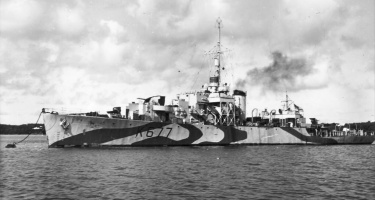 |
Frigates like the River-class added considerable anti-submarine capabilities to the Royal Navy, which ultimately helped it prevail against the German U-Boat onslaught during the Battle of the Atlantic. Despite their simpler design, they carried the same anti-submarine weaponry and equipment as a destroyer. |
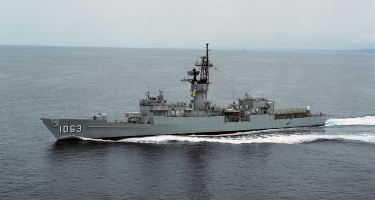 |
During the Cold War, frigates like this Knox-class remained specialized in anti-submarine warfare given the threat of Soviet submarines cutting off NATO's supply lines in the North Atlantic. The addition of helicopters greatly expanded their ASW capabilities. |
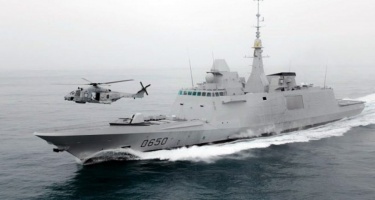 |
Modern frigates like the Franco-Italian Aquitaine-class (FREMM) have further blurred the line with destroyers and can now be optimized for many roles beyond just ASW such as air defense, often armed with the same advanced radar systems (like the AEGIS) that are used by air defense destroyers. |
Other Escorts
Sloop (SL): Another small ship type (1,000-1,500t) ship that was re-introduced in WW1 by the Royal Navy as an anti-submarine ship larger than a corvette. Sloops were slow and relatively weakly armed except in terms of anti-submarine armament (depth charges, and in WW2 ASW mortars) but were capable of functioning as ocean escorts as well as colonial gunboats and coastal defense ships. Sloops were known as avisos in French and Italian navies which were the other main users of this type, although modern avisos are more akin to corvettes (see below). Although the US never designated any WW1-WW2 ship as a sloop, the larger Coast Guard cutters fulfilled a similar role during wartime (indeed, Lend-lease supplied cutters in the Royal Navy were designated as sloops). Sloops became obsolete after WW2 and for purposes of this site, all escort ships up to WW2 that cannot be adequately categorized as corvettes or frigates are designated as sloops.
Corvette (FS): At around 500-1,500t, this is the smallest surface ship type that is covered on this site. Corvettes originated as the smallest possible anti-submarine ships capable of ocean escort duties. They are also considerably slower than most other escort types, just fast enough to keep up with merchant ships. Nevertheless, corvettes gradually evolved to be quite capable ships especially for navies that could not afford larger combat vessels. All escort ships that cannot be categorized as frigates due to their smaller size, such as the Japanese Kaikoban ships of WW2, are designated as corvettes in this site. Given their combat capabilities, all corvettes are included in this site even when they fall below the 1,000t threshold for inclusion. Some missile or patrol boats are often referred to as corvettes in which case national designations will be taken into account.
Guided Missile Corvette (FSG): The Soviet Navy was a major user of corvettes which (like frigates) were known as Guard Ships, and were usually armed with anti-ship missiles effectively turning them into modern versions of the turn-of-century torpedo boat. These became popular options for smaller navies since these small ships were capable of sinking much larger warships, as evidenced by the sinking of an Israeli destroyer, the Eilat, by an Egyptian missile boat in 1967. The most modern Russian corvettes can even launch cruise missiles.
Patrol Gunboat (PG): Patrol gunboats are typically small, lightly-armed ships designed for coast guard duties but which have ocean-going capability. The US Coast Guard typically refers to them as cutters, although they are roughly equivalent to sloops (the Royal Navy's Banff-class in World War II were USCG Lake-class cutters supplied via Lend-Lease). For purposes of this site, patrol gunboats are distinguished from the newer patrol ships by having guns of at least 76-mm caliber and no helicopter capability (though the larger classes could carry aircraft). Coast guard patrol gunboats/cutters are designated WPG on this site.
Patrol Gunboat-Icebreaker (PGB): A larger patrol gunboat with icebreaking capability. Used only by a few northern navies. Coast guard patrol gunboat-icebreakers/cutters are designated WPGB on this site.
Offshore Patrol Ship (PSO): The offshore patrol ship (better known commercially as an Offshore Patrol Vessel, or OPV) is a modern ship type usually of under 2,500t developed during the second half of the Cold War for patrolling a country's economic-exclusion zones or other forms of coastal/offshore protection. They are of similar size to corvettes or even small frigates but less well armed aside from a small main gun and possibly some anti-air defense although they are usually large enough to carry a helicopter and in some cases, even a helicopter hangar. OPVs are becoming increasingly popular among smaller navies, particularly those with large coastlines or maritime interests but their actual combat capability is much reduced even compared with smaller ships like corvettes. National designations are used to differentiate PSOs from other similar ship classes, for example with the use of NATO's P pennant rather than F. Coast guard offshore patrol ships/cutters are designated WPSO on this site.
Patrol Ship (PS): The designation of patrol ship on this site is reserved for those ships which do not have large enough guns to be classified as a patrol gunboat (PG), nor any kind of helicopter capability. Only classes of 1,000t or greater and which have at least some kind of cannon armament are included. Coast guard patrol ships/cutters are designated WPS on this site.
Patrol Ship-Icebreaker (PSB): A larger patrol ship with icebreaking capability. These is no distinction with offshore ships as these have, by definition, offshore capability. Coast guard patrol ship-icebreakers/cutters are designated WPSB on this site.
Submarine Chaser (PC): A small type of patrol boat that was used for coastal (rather than oceanic) anti-submarine duties. Hundreds were built during World War II by both Allied and Axis navies and averaged around 500t displacement or less. Many were offered as Lend-Lease and later sold off to smaller navies in the post-war period, although the Soviet Union also built a considerable number during the Cold War. They have been largely replaced by corvettes and other more powerful anti-submarine patrol ships.
Multi-Role Vessel (MRV): A relatively recent design for small ships designed for more than just patrol roles, such as amphibious operations, littoral combat, law enforcement and more. Following recent trends towards exportable, modular designs, ships like the Dutch Austral-class can be built according to multiple specifications.
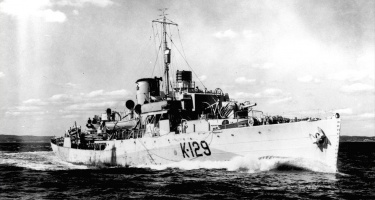 |
The Flower-class was an iconic family of World War II corvettes that proved to be vital assets for the Royal Navy's anti-submarine capabilities during the Battle of the Atlantic. Despite their small size, they were armed with radar and sonar. |
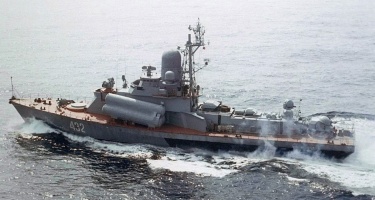 |
The emergence of guided anti-ship missiles added significant firepower to corvettes. Nobody took advantage of htis this more than the Soviet Navy which built large numbers of missile corvettes like the Nanuchka-class which, much like the torpedo boats of a past era, represented a significant risk to larger ships. |
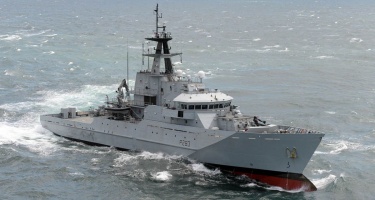 |
Offshore Patrol Vessels like the UK's River-class are now used to police exclusive economic zones (EEZs) and protect other maritime assets like oil rigs and fisheries. They are typically not as well armed as other warships but many are large enough to carry a helicopter. |
Submarines
Submarine (SS): Submarines were developed in the late 19th century but came into maturity in World War I where they were used with tremendous success by the German Kaiserliche Marine against Allied shipping, a formula that was later repeated in World War II. World War II-era submarines were mostly designed to attack surface ships rather than other submarines; as such they are often referred to as patrol submarines, with the larger and faster types considered fleet submarines given their ability to operate alongside the battlefleet. Size and displacement varied from the 750t of the British U- and V-classes designed for Mediterranean operations or the 850t of the German Type VII-class Atlantic raiders (the largest class of submarines ever built with over 700 boats commissioned) to the nearly 2,500t of the US Gato/Balao/Tench-class fleet submarines designed for Pacific service. A few SS classes were built after World War II, notably the mass produced Soviet Whiskey-class.
Attack Submarine (SSK): Also known as "hunter-killer" or diesel subs, attack submarines are designed both against surface ships as well as submarines themselves, the latter which was not suitable for patrol submarines given their lack of detection capabilities as well poor submerged performance. SSKs eventually adopted the now-standard "teardrop" hull design and modern designs also incorporate air-independent propulsion which allows them longer submerged times. Although modern SSKs are mainly employed as coastal forces (leaving blue ocean missions for nuclear-powered SSNs), their ability to shut down their diesel engines and run fully silent gives them an advantage over nuclear subs, and makes them deadly even in the hands of smaller navies. To date, only the US, British, and French navies have ceased operating SSKs, while the Russian navy retains a mix of both diesel and nuclear boats.
Coastal Submarine (SSC): These are smaller submarines explicitly designed for coastal operations. Normally displacing 1,000t or less, they are nevertheless capable of taking out large surface ships and as a result are included on this site. The designation does not make a distinction between modern types with anti-submarine capability or World War II (and earlier) types that were intended solely against surface ships.
Cruiser Submarine (SC): In the pre-war years, some nations designed particularly large submarines with expanded range and more powerful deck armament. Although impressive at first glance given their size, cruiser submarines proved slower and more vulnerable than smaller submarines and so the concept was largely abandoned by World War II, with the Japanese Navy's Type C submarines being the only ones of these kind that were still built during wartime.
Submarine-Minelayer (SM): As the name implies, this is a submarine whose main role is to lay mines. These include conversions as well as a few purpose-built classes.
Nuclear Attack Submarine (SSN): The development of nuclear powerplants small enough to be carried in a submarine revolutionized naval warfare and made SSNs among the most feared weapons of the sea, equivalent to capital ships in the sense that they were capable of taking out even the largest warship. The US and Soviet navies built up massive fleets of SSNs during the Cold War that were in a constant cat-and-mouse game across the oceans of the world even in peacetime. SSNs are able to remain submerged for months, though the disadvantage is that their are noisier than diesel boats due to the need for the nuclear reactor to remain active at all times, even when still. Nevertheless, modern SSNs like the US Navy's Virgina-class or the Royal Navy's Astute-class are among the quietest submarines in service, and have frequently appeared undetected next to opposing carriers during naval exercises; a frightening reminder of what they would be capable in wartime. Modern SSNs are also formidable land-attack platforms, being able to carry weapons such as Tomahawk missiles, and many are also fitted with compartments for launching special forces for littoral operations. Some, like the Russian Yasen-class, essentially function as both attack (SSN) and missile submarines (SSGNs).
Guided Missile Submarine (SSG): A diesel-powered version of the more widely-produced SSGN (see below), of which the Soviet Juliett-class was the sole purpose-built class along with two US boats (USS Grayback and USS Growler).
Nuclear Guided Missile Submarine (SSGN): Submarines proved ideal as cruise-missile carriers, a role which found much acceptance in Soviet naval doctrine which relied heavily on mass cruise missile strikes against US and NATO navies, particularly their valuable carrier battle groups. Almost all Cold War SSGN classes were Soviet, though the end of the Cold War resulted in the US converting some its Ohio-class SSBNs into Tomahawk missile-armed SSGNs, albeit mostly for strikes against land targets rather than against surface ships.
Ballistic Missile Submarine (SSB): A diesel-powered version of the more widely-produced SSBN (see below), of which the Soviet Golf-class was the sole purpose-built class.
Nuclear Ballistic Missile Submarine (SSBN): By far the most feared and destructive weapon of war ever created. Submarines proved to be a uniquely useful platform for launching ballistic missiles given that they could do undetected from any ocean in the world, their survivability in the event of a nuclear first-strike thus made it inevitable that any surprise nuclear attack by either of the superpowers would be met with a devastating response by the other. A single modern SSBN armed with submarine-launched ballistic missiles (SLBM) with multiple warheads could strike nearly 200 different targets. Smaller nuclear powers like Britain and France have chosen to rely on a minimal force of SSBNs (of which at least one is always on patrol) exclusively for their nuclear deterrents while the US and Russian navies possess much larger fleets though much reduced from their Cold War peaks. SSBNs also have the distinction of being among the heaviest ships in service today, in particular the Soviet Typhoon-class which displaced as much as a World War II carrier.
Radar Picket Submarine (SSR): Submarines were also used by the US Navy for its radar picket concept to warn the battle fleet of impending air attack. Most were conversion of earlier World War II ships though two small purpose-built classes were designed (one nuclear-powered and designated SSRN). The concept did not prove particularly successful.
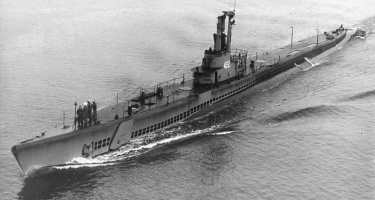 |
Submarines came of age during World War II where they were the pre-eminent threat to Allied shipping and also capable of sinking even the largest warships afloat. Boats like those of the Tench-class could stay on patrol for nearly three months and helped decimate Japan's merchant navy. |
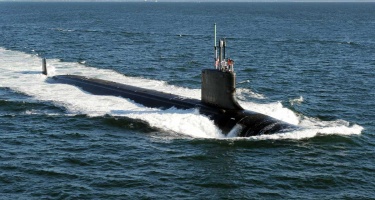 |
Submarine technology vastly improved during the Cold War making submarines capable of diving deeper and moving faster underwater which allowed them to actively hunt other submarines. Nuclear power also allows them to remain submerged almost indefinitely while on patrol, although this Virginia-class boat is making a brief exception. |
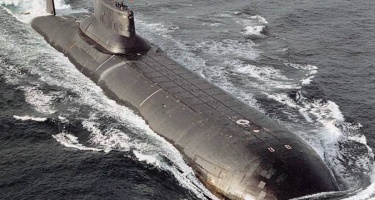 |
Ballistic missile submarines like the massive Typhoon-class are the most devastating weapons ever created by man, and are by far the most important assets that a nuclear power can posses. Only a handful of navies have the technological prowess and resources to operate them. |
Amphibious Vessels
Landing Craft, Assault (LCA): The standard landing craft used by the Royal Navy for landing up to 31 assault troops through a bow ramp. A similar US version is the LCVP.
Landing Craft, Vehicle, Personnel (LCVP): Similar to the British LCA, the LCVP was popularly known as the 'Higgins Boat' and was used extensively during World War II with over 23,000 built. It could carry up to 36 troops. Unlike the LCA, it could carry small vehicles like a Jeep and was faster. It also made extensive use of plywood to ease mass production but as a result it offered no armor protection for troops.
Landing Craft, Mechanized (LCM): A slightly larger multi-purpose landing craft than the LCA/LCVP (and made of steel) designed to be able to transport heavier vehicles, including a tank, or up to 100 men depending on variant.
Landing Craft, Infantry (LCI): A much larger vessel capable of directly landing as many as 200 assault troops though one or more ramps, either on the bow or the sides; the latter being the more efficient. The LCI was the largest vessel in World War II capable of directly landing infantry on shore.
Landing Craft, Tank (LCT): Similar to the LCI but designed to land vehicles (including tanks) directly on shore through a large bow ramp.
Landing Craft, Utility (LCU): A large, multi-purpose landing craft capable of carrying either assault troops or vehicles. Most post-war landing craft are LCUs.
Landing Craft, Air Cushion (LCAC): In the post-war years, hovercraft have proven to be faster and more flexible vehicles for direct seaborne assaults than landing craft. They are extensively used by most modern naval powers; at over 500t, the Soviet Zubr-class LCACs are the largest in the world and have even been exported to a NATO nation (Greece).
Landing Ship, Tank (LST): No other ship exemplifies the amphibious operations of the 20th century than the LST. It was originally a British design for an ocean-going ship capable of carrying supplies or vehicles (including tanks) and landing them directly on a shore without the need for a pier or a dock thanks to large bow doors and a ramp. Over one thousand of these ships were built (mainly in the US of which many were supplied to the Royal Navy via lend-lease) and they were used in every Allied amphibious operation during the second half of World War II. LSTs continue to be built and are a cheaper option for smaller navies which lack the funds for more sophisticated amphibious ships.
Landing Ship, Medium (LSM): A smaller version of the LST, usually averaging around 1,000t or less. Over 500 were built by the US during World War II and they have also become popular in the post-war period, particularly by smaller navies that cannot afford larger landing ships. For example, the Soviet/Polish Polnocny-class was one of the mainstays of Warsaw Pact amphibious forces and that of other allied navies.
Landing Ship, Infantry (LSI): These were the designation used for British World War II landing ships that carried infantry. They were usually converted from cargo or passenger ships or ferries and designed to launch (and recover) landing craft, infantry (LCI) at some distance from the shore using davits or cranes, thus differentiating them from normal troop transports. Given that none of them were purposely-built, they were not arranged by classes but rather by size or type including LSI(H) (heavy), LSI(M) (medium), and LSI(H) hand-hoisting. The largest LSIs could carry as many as 2,500 men. The US equivalent to these ships was the attack transport, personnel (APA).
Landing Craft Carrier (LSC): Similar to the LSI in that they were designed to launch landing craft mechanized (LCMs) at a distance from shore, these craft carrying supplies, vehicles, or troops. Like the LSI, they were usually converted from civilian ships. Aside from the basic LSCs, similar ships were designated LSS (stern chute) or LSG (gantry) which used more sophisticated methods for launching their landing craft and in some ways were precursors to the landing ship, dock (LSD). The US equivalent to the basic LSCs was the attack transport, cargo (AKA).
Landing Ship-Minelayer (LSTM): A relatively rare post-war hybrid of a landing ship (either LST- or LSM-sized) and a minelayer, of which only a few classes exist.
Amphibious Transport, Personnel (LPA): These were US ships originally known as attack transport, personnel (APA) and served an identical function to the British LSIs. Unlike the LSIs, they were purpose-built but based on standardized merchant hulls and nearly two hundred were built during World War II. Most were retired after the war though existing ones were redesignated amphibious transports (LPA).
Amphibious Transport, Cargo (LKA): These were US ships originally known as attack transport, cargo (AKA) and served an identical function to the British LSCs. Unlike the LSCs, they were purpose-built but based on standardized merchant hulls and over one hundred were built during World War II. Most were retired after the war though existing ones were redesignated amphibious transports (LKA).
High-Speed Transport (APD): A number of World War I-vintage "flush deck" destroyers as well as Destroyer Escorts (DE) were converted during World War II into High-Speed Transports, which could carry a small assault units such as special forces or underwater demolition teams into hostile shores.
Landing Ship, Logistics (LSL): A large, general purpose landing ship of which the sole designation has been used for the post-war Sir Lancelot-class ships.
Landing Ship, Dock (LSD): The landing ship, docks of the US Navy's Ashland-class were the most advanced type of amphibious ship developed in World War II. Instead of using bow doors like an LST, an LSD used a docking well that allowed landing craft to be launched without the need of a hoist and in rougher seas than would be capable with a davit or crane. The increasing use of amphibious tractors towards the end of the war also made LSDs a preferable design in the post-war years and they continue to be built by navies around the world. Modern LSDs typically have helicopter decks as well, and some like the Soviet Ivan Rogov-class have bow doors which give them a dual LSD/LST function.
Landing Platform, Dock (LPD): Confusingly similar in appearance and design to the LSD, the key distinguishing feature between the two types of ships is that the LSD is primarily designed to transport equipment and vehicles whereas the LPD is primarily designed to transport assault troops (though both can carry either cargo). As a result, LPDs typically have larger helicopter decks which can cover the rear half of the ship, as well as a hangar which is often lacking in an LSD. Both ships have docking wells though these tend to be slightly larger in LSDs in order to be able to carry heavier vehicles like tanks. The largest LPDs can carry around 700 fully equipped assault troops.
Landing Platform, Helicopter (LPH): Also confusingly similar to basic helicopter carriers (CVH), the main difference being their purely amphibious role rather than, for example, ASW. LPHs can be easily distinguished from other amphibious ship types by their large helicopter decks which extend throughout the length of the ship as opposed to just the rear half like LPDs or LSDs, and their island superstructures which are similar to that of aircraft carriers. Not surprisingly, the first LPHs were converted from older World War II-era carriers; the Royal Navy referred to these as "commando carriers". Although they vary in size, the largest LPHs like the US Iwo Jima-class can carry around 1,800 troops.
Landing Helicopter, Assault (LHA): The ships of the Tarawa-class were the first attempt by the US Navy to create an amphibious ship capable of both airborne and seaborne assault. As such, they are almost identical to LPHs but with the addition of a docking well. Adding to the ongoing confusion of amphibious ship types, the LHA was succeeded by the nearly identical landing helicopter, dock (see below) only to revert back to LHAs in the more recent America-class, though with much more advanced capabilities for air operations (including V/STOL aircraft). To make matters worse, the first two America-class ships lack docking wells which makes them LPHs in all but name.
Landing Helicopter Dock (LHD): Virtually indistinguishable from LHAs which begs the question of why a new designation was needed for the US Navy's Wasp-class ships whose main improvements were the ability to carry fixed-wing V/STOL aircraft (Harriers) as well as larger docking wells which could operate LCAC hovercraft. Overall, a large LHD can carry almost an entire Marine Expeditionary Unit (MEU) in a single ship including its ground, aviation, and logistical components. Most non-US navies prefer the LHD designation for ships of this type, such as the French Mistral-class and the Spanish Juan Carlos I-class. As such, this is the preferred designation on this site although national preferences will be respected.
Amphibious Command Ship (LCC): A large ship used as a command post for amphibious operations. These ships had extensive communications equipment as well as spaces for operations and intelligence planning. After World War II, these ships have increasingly served as general fleet command ships rather than focus specifically on amphibious operations.
Landing Ship, Headquarters (LSH): The Royal Navy designation for an amphibious command ship during World War II.
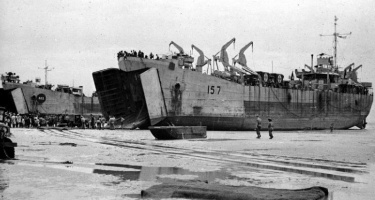 |
As much of a war-winning weapon as you could find in World War II, the Landing Ship Tank allowed the US and Royal Navies to ferry large amounts of men, vehicles, and material and land them directly on a beach. They remain the most widely used amphibious ship to this day. |
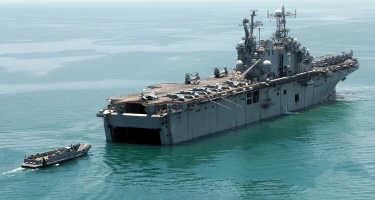 |
Is it an aircraft carrier or a landing ship? Most large amphibious vessels like this Tarawa-class LHA have flat decks and hangars that enable them to operate helicopters and even V/STOL aircraft like the Harrier. Additionally, they have floodable docking wells to launch their landing craft. |
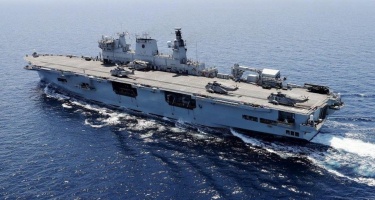 |
Ships like HMS Ocean, an LHD, are not only useful in the amphibious assault role but can also be used for special forces and counter-terrorism duties as well as for humanitarian aid missions. Under smaller navies, they also often serve as fleet flagships (HMS Ocean is now Brazil's NAM Atlântico). |